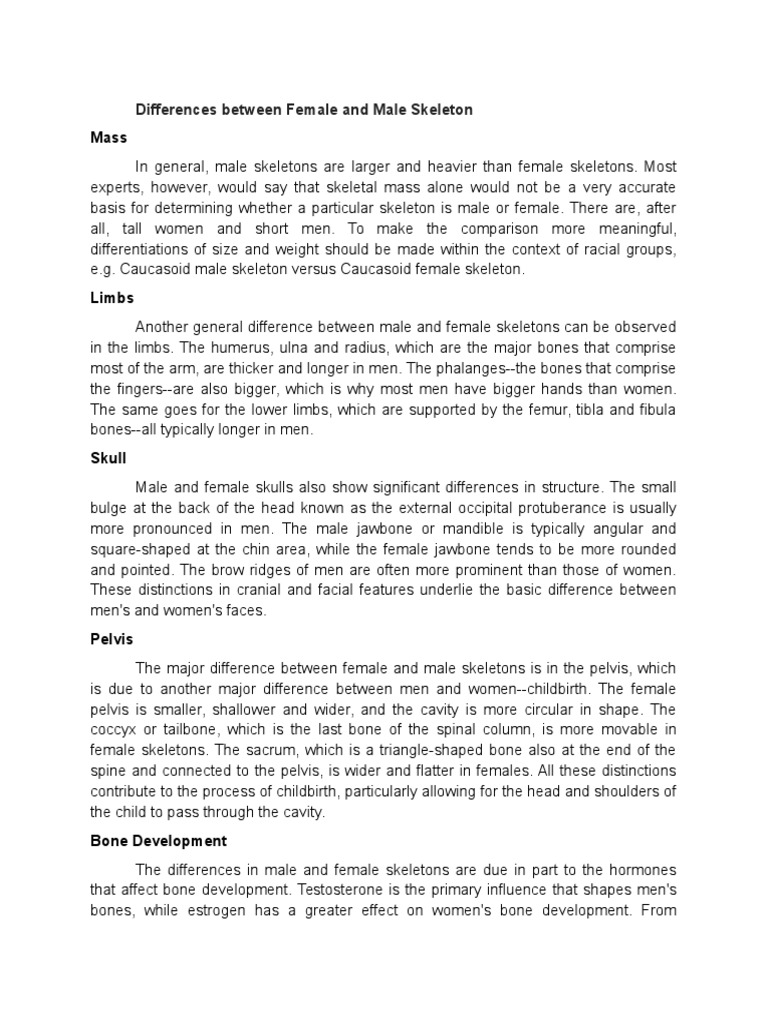Are male and female skeletons different? This seemingly straightforward inquiry provokes a delightful complexity within the realms of anatomy, forensic science, and the broader perspective of cultural relativism. In examining the skeletal variations between sexes, we unearth not just biological and anatomical disparities, but also cultural significances and implications that underscore these differences. The interplay between biology and culture is essential in understanding how societies interpret and interact with anatomical distinctions.
The physiological delineations between male and female skeletons are grounded in evolutionary biology. Variations emerge in several anatomical features, primarily driven by the distinct reproductive roles of each sex. The pelvis, for example, is one of the paramount areas of differentiation. Female pelvises are generally broader and exhibit a wider subpubic angle, which facilitates childbirth. Conversely, male pelvises tend to be narrower and more robust, reflecting adaptations that support bipedal locomotion and physical strength.
Another notable distinction lies in the overall size and robustness of skeletal components. Typically, male skeletons are larger and denser, with greater muscle attachment sites indicative of heightened physical exertion throughout evolutionary history. The skulls of males often exhibit features such as more pronounced brow ridges and larger mastoid processes, signifying greater musculature and physical strength. These differences not only highlight evolutionary adaptations but further propel conversations about gender roles throughout human history.
Within the discipline of forensic anthropology, the delineation between male and female skeletons is critical to establishing the biological profile of skeletal remains. Forensic scientists utilize various morphological features, measured quantitatively through techniques such as metric analysis, to ascertain sex from skeletal remains. Rib morphology, cranial features, and pelvic dimensions serve as key indicators in this determination process. Moreover, the pelvis is considered the best skeletal indicator for sex determination, yielding correct classifications upwards of 95 percent in certain populations.
Yet, when confronting the application of these physical differences through a cultural relativism lens, the interpretation of sex-based anatomical distinctions grows more nuanced. Different cultures possess varied perceptions regarding gender and its representation. In some societies, the stark anatomical divisions between male and female skeletons are imbued with specific meanings, influencing gender roles, expectations, and identities. For example, certain indigenous cultures may embrace multi-gender identities that complicate the binary understanding of male and female anatomical distinctions.
Challenges arise when attempting to apply a rigid classification based solely on skeletal features within a forensic context. The implications of cultural relativism illuminate concerns surrounding the oversimplification of anatomical differences. Many societies recognize individuals whose identities do not conform strictly to male or female. As such, forensic scientists and anthropologists are urged to approach skeletal analysis with a degree of flexibility and awareness of cultural diversity. Failing to do so may lead to analytical oversight and misrepresentation of individuals within archaeological and forensic investigations.
Furthermore, advancements in genetic analysis have begun to challenge traditional notions of sex determinism based solely on skeletal remains. DNA analysis can provide insights that skeletal morphology might not – revealing intersex variations and complexities of sexual differentiation that remain largely invisible to conventional osteological methods. This technological shift also prompts discussions about the ethical implications of labeling and categorizing individuals based on skeletal characteristics, particularly in light of evolving understandings of gender identity.
It is critical to delineate between sex, a biological construct, and gender, a sociocultural construct. The disparity between male and female skeletons is just one aspect of a multilayered discourse on identity, culture, and representation. In many ways, the differences in anatomy shed light on the complexities inherent within discussions of gender and sex. Cultural relativism posits that each society’s interpretations of anatomy and identity deserve acknowledgment and respect, encouraging scholars and practitioners alike to traverse beyond mere biological determinism.
Moreover, the concept of cultural relativism calls for a sensitive recognition of how anatomical differences are emblematic of broader societal narratives and practices. The understanding of male and female skeletal diversities brings a rich repository of insights regarding societal constructs surrounding masculinity and femininity. It is imperative for anthropologists and forensic specialists to engage with these interpretations critically, ensuring that they do not homogenize identities based on physical characteristics alone.
In summation, the inquiry into whether male and female skeletons differ thus transcends anatomical examination. It invites us to contemplate the implications of these distinctions through a cultural lens, revealing the intricate interplay between biology, identity, and society. While skeletal variations provide valuable forensic and anthropological insights, they also propel humanity into a broader dialogue about the nuanced embodiment of gender. Such awareness challenges preconceived notions and augments our understanding, fostering a holistic appreciation of human diversity.
